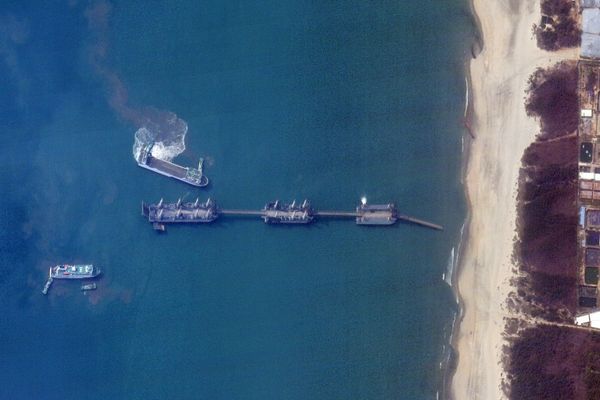
Ballycotton is the kind of place that people like to call a hidden gem. But it’s hard to stay hidden when you’re a picture-perfect fishing village a short drive from the city of Cork, surrounded by sandy beaches and home to several fine pubs.
In the summer it’s popular with walkers, anglers and foodies, but on a windy winter’s day we find a parking spot right outside Cush, an old pub turned restaurant that is regularly listed among the best places to eat in Ireland. We have booked lunch here before our walk.
Setting out on a long hike with a full stomach isn’t ideal, but the forecast is for an imminent burst of heavy rain followed by an afternoon of gales and sunshine – the full Irish, meteorologically speaking.
We decide on a leisurely meal by the window, watching the storm outside with a certain degree of smugness, and by the time the coffee has arrived, Ballycotton pier is bathed in sunshine and we’re ready to set off.

This coastal path connects Ballycotton to Ballyandreen beach in the west. Out and back, it’s about 5½ miles (9km). We could head inland at Ballyandreen and loop back to Ballycotton, but the views on the cliffs are so wonderful it seems a shame to walk away from them.
The trail begins with a nod to the village’s rich maritime history, as we pass the Mary Stanford, a lovingly restored RNLI lifeboat that now sits on a plinth overlooking the cliffs. In 1936, the boat’s crew endured 49 hours at sea to save the lives of eight men onboard a lightship that had broken loose from its moorings and was drifting in a storm. The rescue ranks among the most daring in the organisation’s history.

It’s not the only reminder of the Atlantic’s perils, and along the way we encounter several memorials to crew who were less fortunate, but even on a blustery day like this the path is never too exposed or difficult. For the most part, it is also flat, leaving us plenty of time to savour the views. Which is fortunate because there’s a lot to take in.
On a trail like this, it can seem as if the whole world has been divvied up according to the rule of thirds. The view in every direction is dominated by a brilliantly blue winter sky, and the looming but still-distant threat of the squall that’s blowing in from its edges. Below us, the Celtic Sea is busy lashing itself against the rocky coastline, and because the land side of this path is mostly made up of steep ridges covered in thick gorse, dry land makes up only a small amount of the scene.

What’s there is is gorgeous: dark, craggy rock faces climb out of the water before slipping under a thick carpet of grasses and gorse, with sporadic wildflowers popping out in contrast to the greens and browns.
Desiccated wooden fenceposts jut out of the thicket, as if to remind us that humans have been trying, with limited success, to control the wildness of this coastline for a long time. Even the trail we’re walking on, which is well maintained, is today mostly hidden by puddles and mud, and on anything other than a hot summer’s day, wellies would be as good a choice as walking boots.
As we approach Ballytrasna beach, the path descends to a little stream, where a handful of stepping stones take us over the water and back on the path to Ballyandreen, but not before we take a detour down to the sea.

Ballytrasna is magical at any time of year, especially in spring and early summer when the steep grassy banks descending alongside the steps to the beach are bright pink with sea thrift and other flowers. In summer it’s alive with birds nesting on the cliffs, and the occasional dolphin can be spotted out to sea. It is also a popular bathing spot, and for those not in a rush it would make a great place for a picnic on a warmer day.
In general, the coastline around Ballycotton is great for sea swimming, with several wonderful beaches within walking distance of the village, but on a cold day the prospect of a swim isn’t that appealing, so we agree to come back soon when the temperature is more agreeable. For a few quiet minutes, though, we are extremely happy to have the place to ourselves; it’s easy to forget that we’re barely 40 minutes from Cork city.
Start/end Ballycotton village
Distance 5½ miles (9km)
Time 2 hours
Total ascent 156 metres
Difficulty Easy
Google map of the route
Retracing our steps up along the stream, we rejoin the path and head west, working our way up a gentle incline towards a rocky headland. Locally, it’s referred to as the Hump, but the unimaginative nickname belies its incredible beauty, and as we reach its ridge we’re stopped in our tracks by the panoramic sea views from east to west, and by the way that the late afternoon sun has cast a gilded edge on the cliffs and the distant farmlands on the other side of the bay.
This is an Irish winter walk at its very best: not a soul in sight, and because we chose to ignore the weather warnings, we have been rewarded with idyllic conditions. Had we set out expecting sunshine, we would be soaked to the bone by now.
From the Hump, it’s about half a mile down to Ballyandreen, and you’ll know you’re close to the turn when you can see the battered wreck of the MV Alta, stranded on the rocks just west of the beach. Now known as the Ballycotton ghost ship, the Alta was abandoned in the middle of the Atlantic in 2018 while attempting a voyage from Greece to Haiti, only to wash up in Cork during a bad storm almost 18 months later.
We choose to retrace our steps rather than take the road back to Ballycotton, knowing we’ve had our backs to so much of this trail’s scenery.
Inevitably, the gales pick up again and the skies darken, and if we weren’t already aware of how quickly the weather can change at this time of year, the black lighthouse on Ballycotton Island comes into view, just across the sound from the pier. But it’s close now, and we’re carried back swiftly with the help of a tailwind and the promise of another pint of porter in Cush, just to make sure it really was that good.
The pub

The bones of Cush have been in situ for well over 100 years, and while the restaurant side of it is as sophisticated as any urban eatery, there’s still the comforting patina of age in the bar, along with an extensive collection of photography that speaks to the village’s seafaring traditions.
Head chef Dan Guerin is a Ballycotton native who has honed his skills in some of Ireland’s top kitchens, and since returning home he has created a menu that feels every bit as local as the pub itself, marrying contemporary style with fresh, seasonal ingredients. In 2022, Cush earned a Bib Gourmand in the Michelin Guide, but the accolades haven’t gone to anyone’s head, because although the food is spectacular, you can just go for a packet of crisps and a pint if that is all you’re after.

Alternatively, there’s an à la carte or three-course set menu for €40. We shared West Cork scallops, boned and rolled quail, a razor clam risotto and a roast saddle of wild Irish deer. Our only complaint is that we didn’t order the locally smoked haddock too.
Half a mile up the road is another fine pub, the Blackbird, that’s well known for its live music.
The rooms
Above the pub, Cush has five tastefully decorated en suite doubles with sea views, premium duvets and fine linen. Doubles from €115 B&B, cush.ie







